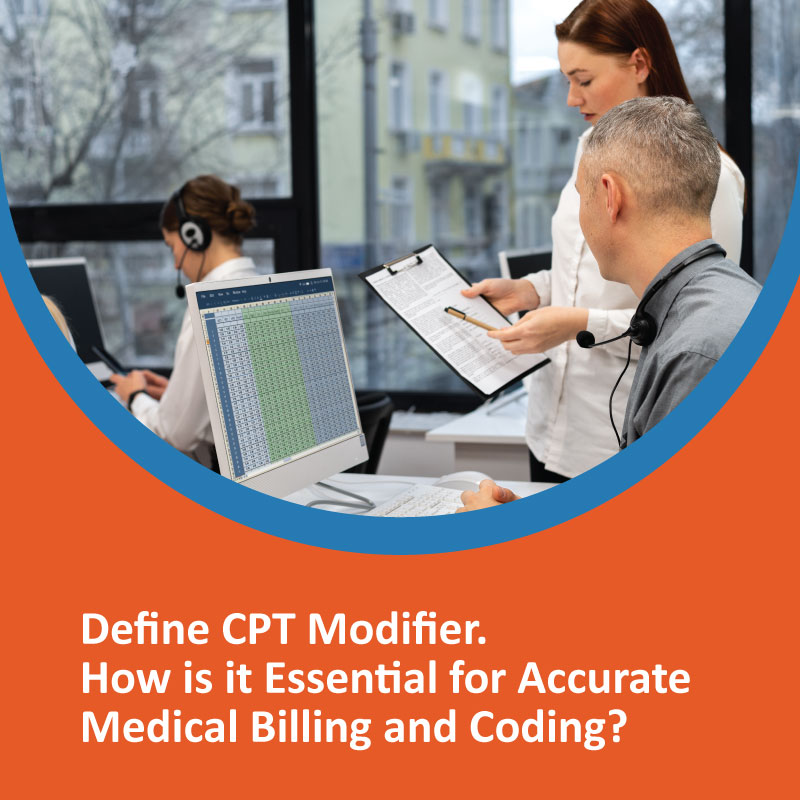Accurate billing and coding are critical in healthcare medical processes. The CPT modifier is one key element that ensures medical claims are processed correctly. These two-digit codes provide extra information about the services healthcare providers offer. By using them correctly, providers can get adequately paid for their services, avoid having claims denied, and follow the rules set by insurance companies.
What is a CPT Modifier?
A CPT modifier is a two-digit code added to the Current Procedural Terminology (CPT) code. It provides extra information about a service that is performed. It also explains the location of a service where it is performed.
In medical billing or coding, modifiers are essential for providing more details about a CPT code to show that a process was different in any way. They help explain special situations where a procedure is not exactly what is typically expected but still uses the same basic CPT code. This helps make the billing and payment process more transparent.
Why are CPT Modifiers Important?
CPT modifiers are an essential part of the healthcare coding process for some reasons:
Accurate Billing and Reimbursement:
When healthcare providers use the correct CPT code, they ensure that they receive the proper payment from the insurance company and that the patient has received the proper treatment from service providers. In case of a wrong procedure, healthcare providers are responsible for reimbursement.
Claims Processing and Reducing Denials:
Payers often use modifier codes to predict how a claim should be performed. Using any wrong modifier code may result in a failing process and claim denials or delayed payments.
Compliance:
Different types of payment payers, such as Medicare and private insurance companies, have some rules to use modifiers. Wrong usage can result in compliance issues and audits.
Communication:
Modifiers provide a standardized way for healthcare providers to communicate the nuances of care given. They describe services performed in a way that goes beyond the general CPT code.
Types of CPT Modifiers
Hundreds of CPT modifiers are used for different situations, each serving a distinct purpose. Here are some commonly used CPT modifier codes:
1. Modifier 25 (Separate E/M Service)
This type of modifier is used when a separately identifiable evaluation and management (E/M) service is provided on the same day as another procedure.
Example: If a patient is served for a fever and treated for a small cut, modifier 25 is added to show that both services were done separately.
Code: 99213-25 (office visit) and 12001 (stitch).
2. Modifier 59 (Distinct Procedure)
Used to show that two procedures are unrelated and performed in different areas or at other times.
Example: A patient gets two procedures on different body parts (e.g., hand and foot). Modifier 59 indicates that the procedures are distinct.
Code: 11200-59 (for skin removal on the hand) and 11300-59 (for skin removal on the foot).
3. Modifier 50 (Bilateral Procedure)
The modifier 50 is used when a procedure is done on both sides of the body, such as both knees or eyes. This procedure is also known as a bilateral procedure.
Example: A patient has a knee arthroscopy on both knees. Modifier 50 is added to show it’s a bilateral procedure.
Code: 29881-50 (knee arthroscopy, bilateral).
4. Modifier 22: Increased Procedural Services
Used when a procedure requires more work or time than usual.
Example: A surgeon who performs a more complex surgery than every day needs extra time. Modifier 22 is added to show the extra work involved.
Code: 25447-22 (complex wrist surgery).
When to Use a CPT Modifier
A CPT modifier is used when a medical service is performed under unusual conditions, modified, repeated, or distinct from another service. These situations include:
- When the service is distinct or independent from another procedure on the same day.
- When unusual or more complex circumstances require additional effort or resources.
- When a procedure was done bilaterally.
- When a procedure is altered in some way, the basic definition of the CPT code remains intact.
When you use any modifier, you need to follow the rules. Different types of insurance companies and government sectors may have different rules. These rules show how and when modifiers are used or applicable.
Conclusion
In conclusion, CPT modifiers code is vital in medical billing and coding. After using this code, you can easily understand the services rendered. It also ensures that the healthcare providers are adequately reimbursed for their services or care. The main advantage of using the correct CPT modifier code is that it reduces claim denials and denied payments. In this way, they remain in compliance with payers’ requirements. Modifiers seem like small additions to a code, but their correct use can make a big difference in medical billing and coding accuracy.
FAQ’s
Q1. What is a CPT modifier?
A CPT modifier is a two-digit code added to the Current Procedural Terminology (CPT) code. It provides extra information about a service that is performed. It also explains the location of a service where it is performed.
Q2. Why are CPT Modifiers Important?
CPT modifiers are important for accurate billing and reimbursement of payments. They are also used to prevent claim denials and reduce delayed payments.
Q3. Write the name of some CPT modifier code.
There are hundreds of CPT modifier codes, such as Modifier 25, Modifier 50, and Modifier 59. All these modifier codes are used for different purposes.


